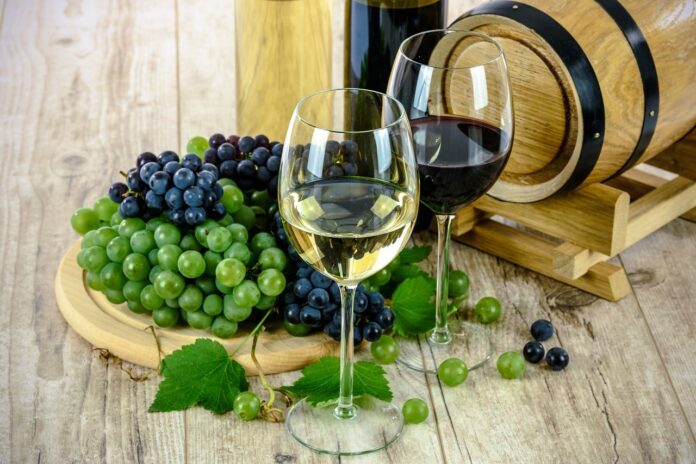Tasting and savouring fine wine is an experience that goes beyond simply drinking; it’s about engaging your senses to fully appreciate the complexity and nuances that make a wine exceptional. Whether you’re a novice or an experienced wine enthusiast, understanding the process of wine tasting can elevate your appreciation and enjoyment of every glass. Here’s an ultimate guide to tasting and savouring fine wine, focusing on five key steps: seeing, swirling, smelling, sipping, and savouring.
- See: Observe the Wine
The first step in tasting fine wine is to observe its appearance. Pour the wine into a glass and take a moment to examine it. Hold the glass up to the light or against a white background to get a clear view of the wine’s colour, clarity, and viscosity.
- Colour: Wine comes in a wide spectrum of colours, from pale yellow-green in whites to deep purplish-red in reds. The colour can provide clues about the wine’s age, grape variety, and even the region where it was produced. White wines generally darken as they age, while red wines become lighter and more translucent over time.
- Clarity: Fine wine should be clear and free from cloudiness, though older wines may have sediment, which is perfectly normal.
- Viscosity: After swirling, observe how the wine forms “legs” or “tears” on the inside of the glass. Wines with higher alcohol content or sugar levels tend to form thicker, slower-moving legs.
- Swirl: Aerate the Wine
Next, gently swirl the wine in your glass. This may seem like a small action, but it’s an important step that aerates the wine, allowing oxygen to mix with it and releasing volatile aromas that help you assess its characteristics. Swirling helps “open up” the wine, especially for younger, more complex varieties like Cabernet Sauvignon or Syrah, which need time to release their full bouquet of scents.
Swirling also gives you a preview of the wine’s body. Fuller-bodied wines tend to cling more to the glass, while lighter wines swirl easily and leave less residue.
- Smell: Engage Your Nose
Your sense of smell plays a critical role in wine tasting. Bring the glass to your nose and take a deep inhale to identify the various aromas. Wine can have an incredibly diverse range of scents, from fruity and floral to earthy and spicy.
- Primary aromas come from the grapes themselves and can include fruits like apple, berry, or citrus.
- Secondary aromas arise from the winemaking process, including fermentation and aging. These can include notes like butter (from malolactic fermentation) or bread (from yeast contact).
- Tertiary aromas develop as the wine ages in the bottle, giving off more complex scents like leather, tobacco, or dried fruit.
Take your time with this step; the more you engage your sense of smell, the more layers of complexity you will uncover.
- Sip: Taste the Wine
Now, it’s time to take your first sip. Don’t rush this step—let the wine linger in your mouth to fully appreciate its flavors and textures. As you taste the wine, focus on the following elements:
- Sweetness: Determine whether the wine is dry, off-dry, or sweet. Fine wines often have a balance of sweetness that complements the other elements.
- Acidity: Acidity gives wine its freshness and liveliness. Wines with higher acidity will taste crisp and can make your mouth water.
- Tannins: Tannins are found primarily in red wines and create a drying sensation in the mouth. They can add complexity and help balance rich, fatty foods.
- Body: Body refers to the weight of the wine in your mouth. Wines can be light, medium, or full-bodied, and this usually corresponds to their alcohol content and grape variety.
- Flavours: Notice how the flavours change from the initial sip to the finish. Fine wines often reveal new flavours as they evolve on the palate.
For instance, Argentinian wine types offer a range of flavors, with Malbec being the star red varietal known for its dark fruit notes and smooth tannins. Meanwhile, Torrontés is Argentina’s signature white wine, characterised by floral and fruity aromas, making it a great choice to pair with lighter dishes or spicy foods.
- Savor: Reflect on the Finish
After swallowing (or spitting, if at a formal tasting), focus on the finish, which refers to how long the wine’s flavours linger in your mouth. A fine wine will have a long, complex finish, with the flavours evolving and changing even after you’ve swallowed. A short finish, by contrast, indicates a simpler wine.
Savouring the wine involves considering how all the elements—aroma, flavour, texture, and balance—come together. Ask yourself if the wine is well-balanced or if certain components (like acidity or tannins) stand out more than others. A harmonious balance between these elements is often a hallmark of a high-quality wine.
Tips for Enhancing Your Wine Tasting Experience
- Use the right glass: The shape and size of your glass can affect how you experience the wine’s aromas and flavours. Use a glass with a wider bowl for red wines and a narrower one for whites to concentrate the aromas.
- Pair with food: Pairing wine with food can enhance both the wine and the meal. For instance, a tannic red wine like Cabernet Sauvignon pairs beautifully with steak, while a crisp Sauvignon Blanc complements seafood dishes.
- Take notes: If you’re serious about refining your palate, jot down notes about each wine you taste. Over time, you’ll begin to recognise patterns in the wines you enjoy and develop a deeper understanding of your preferences.
By following these steps and immersing yourself in the sensory experience of tasting fine wine, you’ll not only enhance your enjoyment but also develop a greater appreciation for the craftsmanship that goes into each bottle.
Help keep news FREE for our readers
Supporting your local community newspaper/online news outlet is crucial now more than ever. If you believe in independent journalism, then consider making a valuable contribution by making a one-time or monthly donation. We operate in rural areas where providing unbiased news can be challenging. Read More About Supporting The West Wales Chronicle























